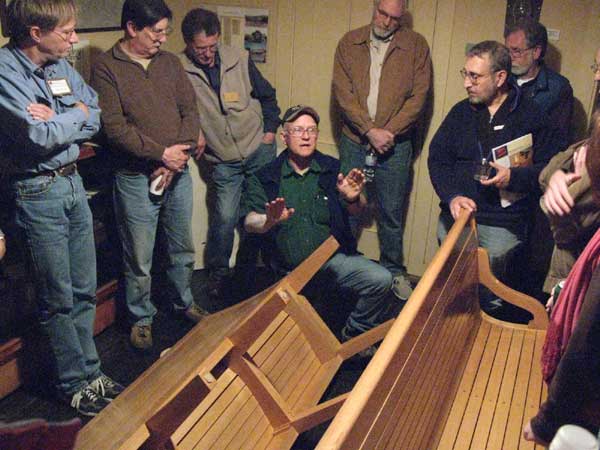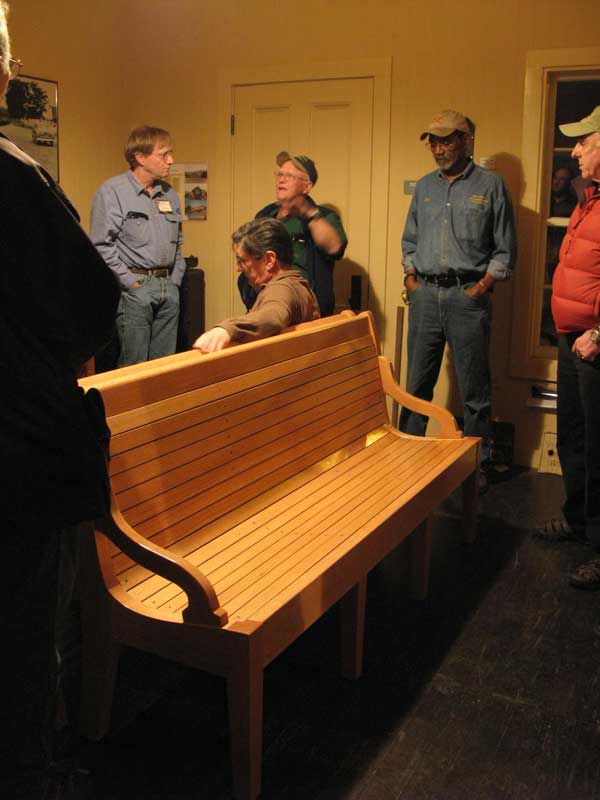
Last meeting
![]()
FBAWA members converged on the Colma Historical Society's Museum at 1500 Hillside Boulevard in Colma for the club's March meeting. Colma is an interesting little town. It has a population of 1,501,700 residents; only 1700 residents are above ground, the rest lie in 17 cemeteries. There is even a pet cemetery, called Pet's Rest. So what in the world was BAWA doing in Colma? We were there to see the railroad benches made by Arnold Champagne for the Railroad Museum at the Historical Society.
Members arrived early so that we all had the opportunity to browse around the museum before the meeting started. There was a legacy of typing and calculating; old typewriters and adding machines, even an early IBM computer with floppy discs, circa 1983. Times have changed. An old Olivetti Lettera 32 typewriter made us reminisce about those old college term papers and compositions.
In one room was a recreated kitchen from the 1940's era. Old wringer washing machines, true ice boxes, corrugated scrub boards and heavy metal irons reminded us that housework of old was a tough job indeed. Another room contained display cases showing memorabilia from the 17 cemeteries with a photograph album for each.
Several nationalities and religious faiths have there own dedicated cemetery: Italian, Irish, Japanese, Chinese, Serbian, Greek, Catholic, and Jewish. Wyatt Earp is buried in the Jewish Cemetery. And, Dusty Rhodes, who has the dubious honor of being the first person to die in a jump from the Golden Gate Bridge, is interred in Colma. Poor Dusty, as the legend goes, was planning to jump from the bridge with a parachute. Unfortunately, as he was preparing to jump, a policeman attempted to restrain him succeeding only in grabbing Dusty's parachute. Poor Dusty went over the rail without it.
But, enough of the past.
Frank Ramsey called the meeting to order at 7:05 pm and moved immediately to announcements.
Announcements:
Per Madsen -- Next month's BAWA meeting will be held at the Senior Center in Foster City. George Bosworth will be presenting "3D Puzzles" with a movie and several puzzles for the members to attempt to unscramble, then reassemble.
In June BAWA will hold its meeting at Rockler in Pleasant Hill. We open meeting agendas for the months of July and August. Members are encouraged to suggest venues or to make presentations. Submit ideas to Per.
Frank Ramsey -- BAWA has a charitable fund set up to commemorate one of its deceased members, Peter Wronsky. There is approximately $710 in the fund and members are encouraged to submit ideas to Frank for how the monies should be used. Frank has suggested local beneficiaries.
The Rebuilding Together project is on for April 25 with two venues being supported. More volunteers are needed.
Stan Booker -- The raffle is for the purple heart and paduak boards. The door prizes for the evening include selections from plastic trays, Japanese Woodworker gift certificate, exotic wood blocks from the Japanese Woodworker, a tool bag, club T-shirts, and a board of Port Orford cedar.
Stan is still collecting old tools for the woodworking school that is being set up in Tanzania with the help of the Asante foundation. It is a project that he will be advising and monitoring closely.
Guests and New Members:
Steve Glaser joined us this evening. He hails from Austin, Texas and has recently relocated to our area.
Ed Marinaro has taken several classes from Arnold Champagne.
Show & Tell:
John Blackmore showed the membership a small cabinet scraper, measuring 1" x 2", that he uses for glue removal. It is available from Lee Valley. John brought in a baby changing table he made 19 years ago just before his first son was born. John has refinished the table and is giving it to the wife of a cousin-in-law who is expecting twins. Good thing it is sturdy and moisture resistant.
Frank Ramsey brought in a cabinet door he made after being inspired by the kitchen cabinets made by John Blackmore. The frame of the door is made by gluing a ½" strip of contrast wood, walnut in Frank's case, to rail/stile material (maple or birch). The cove cut is made in the rails and stiles. A cope cut is made on the ends of the rails. The wide door frame then encloses the panel that is surrounded and held in place by the walnut border strip. Now Frank's unique contribution to this style was to raise the bar to the master class category by making an arched upper rail. He worked for three weeks to create three perfectly matched templates for making the arched rail, the arched trim strip and the arched panel. Wow. What elegance. Very nice work, Frank.
Arnold Champagne presented the two authentically recreated six-foot railroad benches he made for the historical society. After first examining the drawings obtained from the Sacramento Railroad Museum, Arnold carefully considered the structure and joinery then made a full-scale prototype. He changed the seating angle slightly for comfort and presented this piece to the Board of Directors, receiving their enthusiastic endorsement. Now the challenges began. He did not want to use 8' red oak boards because the waste in making 6' benches would have been too great. He was fortunate to find two 12' red oak boards, but needed more. Wood was scarce because builders were still busy. Arnold knew he had to match the grain and color of the wood if the benches were to be perfect. So, he put the two twelve footers on the roof of his car and started a journey. He visited virtually all the lumber dealers in the bay area and he was successful. He had his boards and he got to work. It took five weeks of diligent effort to complete the benches. The benches feature a frame joined with glued floating tenons, two intermediate leg structures, seat and back slats attached to the frame with stainless steel screws and a removable oak plywood back that accesses the interior of the bench. The finish is polyurethane. These elegant, comfortable benches are built to last.


Main Presentation:
Patricia Hatfield, the President of the Colma Historical Society, joined us for the featured presentation for the evening. We split into two smaller groups for a tour of the facilities. In the main building we saw the library, the cemetery display room, the old kitchen, the main museum room where chairs had been set up for the meeting. Pat gave us the demographics for the City of Colma. Colma means "many springs" in the language of the native Americans who lived on San Bruno mountain. Pat explained that the cemeteries are run as tax-free organizations and contribute nothing the tax base of the town. Instead, the town relies mostly on tax revenue from the casino/card room in Colma. Whereas the car dealerships in Colma have been closing, the card room continues to thrive.
Other well-known residents of Colma include William Randolf Hearst, Levi Strauss and the previously mentioned Wyatt Earp.
The museum also includes a blacksmith shop, an old railroad station and railroad loading warehouse and dock. The main railroad line to San Francisco used to run through Colma, but now by-passes it. The old station includes a waiting room, now equipped with the railroad benches made by the club's own Arnold Champagne based on original drawing from the Railroad Museum in Sacramento, and a station master's office. The blacksmith shop, just down the path from the station was full of old tools and equipment from the by-gone era. Most old blacksmith shops later became automobile repair garages.
Before adjourning, we were treated to dinner and dessert by our hosts: grilled chicken, sandwiches, potato salad, apple pie, chocolate cake and cookies. Several of us ate our second dinner that evening. Now BAWA really needs a Refreshments Chairperson. Any volunteers?
John Blackmore